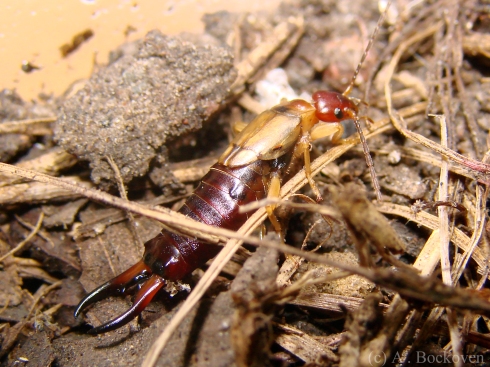(Updated 6/20/17)
The picture below started this post. It is a picture that shows up prominently high on a google image search for ‘fire ant.’ It is also, very clearly, not a fire ant.

Not A Fire Ant
Granted, I spend an unhealthy amount of time getting stung by researching fire ants, and might be presumed to be a bit more familiar with fire ants than the layperson. However, the people who oh-so-proudly and prominently displayed this picture next to a guide for identifying and controlling fire ants were a pest control company, and one could wish that these people would also be a bit more familiar with fire ants than the layperson, particularly as they have taken it upon themselves to educate the public.
I tested my theory that this was clearly not a fire ant by showing it to a non-ant-person, Collin McMichael, a labmate of mine who works on caterpillars and aphids and happened to wander into the room at the right moment. “That’s not a fire ant,” he said.

Here’s another example:

(Not-a-fire-ant brought to you by Pest Mall. Is-a-fire-ant via Fischer Environmental. Thumbs up, Fischer!)
So, I present to you, my collection of ‘Things That Are Not Fire Ants’, as brought to you by the pest control companies of America.
(If you’d like some tips for identifying fire ants, look for a 2-segmented pedicel–the “waist” of the ant–and 10 segmented antennae, the last two segments of which are slightly enlarged to form a club. Their relatively small eyes also set them apart from many of the ants on this page. Also make sure it’s an ant.)
34. Bugsperts Pest Control

33. Structural Termite & Pest Control (this one’s a twofer! neither the big ants nor the little ant are fire ants!)

Bonus: These are probably not fire ant nest mounds, since the funnel shape is acharacteristic, and more common in other genera such as odorous house ants and pyramid ants. Fire ant mounds will usually be rounded (soil & weather permitting) since they build tunnels up into the mound itself to use for thermoregulating their brood.

32. StopPestInfo

31. PestWiki

30. Mosquito Squad

29. Spencer Pest Control

28. ThoughtCo “How To Identify Fire Ants: Are Your Ants Really Fire Ants?”
(no)

27. Terminix


26. Healthline

25. Terro

24. Damn Bugs LLC (this one’s tricky – note the spikes on the back of the gaster and the lack of the 2 segmented antennal club)

23. Noosa Pest Control

22. Heron Lawn & Pest Control

21. Florida Lawncare and Rove Pest Control – Nashville

20 & 19. Green Pest Services


See also below, this company has about four different ants pictured as “fire ants.” It’s impressive. Also, since these are from a list of “common pests of Long Island” and there are no fire ants in New York I really just have no idea what they’re talking about. I’d give them the benefit of the doubt and generously assume they’re using “fire ant” to refer to a whole different type of ant all together (or, you know, four different types) but the biological description is pretty clearly trying to describe S. invicta.
18. Dayton’s Pest Control and Green Pest Services (again!)

17. Fireantswers

16 & 15. Clark’s Pest Control (a two-fer!) and Innovative Pest Control


14. Sterling Pest Control and Technical Pest Services – Houston

13. Falcon’s Pest Control

12. Culpepper Pest Control and Advanced Pest & Weed Management

11. Grandma’s Home Remedies

10. Barrier Termite & Pest Technologies

9. Arista Pest Solutions and Peckitt Pest Solutions and A-Zap Pest Control and Pest Patrol Pest Control

Plus, special mention to non-pest control company, the American Academy of Allergy, Asthma & Immunology.
8. EnviroCon Termite & Pest

7. Frontline Pest Control and Aspect Home & Pest and Orlando Pest Control and Home Protection Pest Control

See also: “This is not a harvester ant” and “This is not an Argentine ant.”
(Aspect has not only borrowed most of its incorrect images from Frontline, but they have also used the same image twice for ticks and fleas.)
6. Adam’s Exterminators

5. Lenny’s Pest Control and John Moore Services and Rush Termite & Pest Control

4. Treasure Coast Pest Control and Mist Pro Outdoor Insect Control

3. Raleigh Pest Control

2. ESI Oscala

1. (And my personal favorite) PestMall

Actually, all the fire ant pictures at PestMall are pretty suspicious but this one’s far and away the best. Look closely. That’s not a fire ant. That’s not even an ant. In fact, let’s hop right out of Hymenoptera altogether.
That, my friends, is an earwig. 10 points and a cookie to anyone who uses Alex Wild’s formula to calculate the Taxonomy Fail Index.
And finally, I’ll leave you with my favorite picture that I stumbled across in my Google image search:

This is a fire fire ant. (FreakingNews.com)
(Let’s be clear, though. Adding flame decals to an ant will not make it a fire ant any more than it will make your car go faster. Nice try Montgomery Pest Control.)
(Bonus: New Orleans pest control has a fire ant that is Not an Argentine Ant.)
Tags: Ants, Earwigs, Fire Ants, Fun, Insects, Taxonomy fail















































Recent Comments